Kitepipe is now a part of Atturra. Read the press release here..
Kitepipe is now a part of Atturra. Read the press release here..

So you’ve recently bought Boomi and are ready to start your first Boomi project—congratulations! Boomi is a top-rated iPaaS for building and deploying seamless integrations. However, assembling the right project team demands careful consideration. As a platinum Boomi partner, we help IT teams navigate this process. Here are the top five questions we are asked by new Boomi customers.
Not necessarily.
Boomi is a highly productive environment, where much can be accomplished in a short amount of time. A proficient Kitepipe Boomi consultant can achieve a comprehensive two-way data integration within 30 to 50 hours. This means if everything is completely specified, and nothing changes, a skilled Boomi consultant can do a project in two to three weeks.
It’s important to note that things are never properly specified, and something always changes. You need to take a flexible approach to Boomi projects that balances expertise and agility. As project specifications often evolve, our experience suggests a Six Sprint Model (described below). This approach typically outperforms having a full-time Boomi resource.
According to Larry Cone, our founder and CEO, “We have done large Boomi services projects that employed four experienced FT consultants for ten months, and projects where we averaged 10 hours/week over three months. The latter are by far more common and appropriate. Most customers do not have the integration projects lined up to keep a FT developer busy, so it makes sense to use a Consultant from Kitepipe as you get started..”
For more on this topic, read our blog, “You Bought Boomi, Now What?”
Sure, if it is a simple, one-way data push.
A consultant with some cloud experience can attend Boomi Jumpstart or free Boomi training, and put together a simple integration. It will look like this:
Image Text: Here is what a simple integration process looks like in Boomi.
On the other hand, if you need handshaking, error reporting, performance tuning, filtering of bad data, or error handling for a fussy API, your Process will end up looking like this:
Image Text: Here is what a complex integration process looks like in Boomi.
Most likely, an existing team member, new to Boomi, a “Boomi Newbie” as we like to say, will not be able to produce this.
Things are much easier if there is a "named" connector available for your integration endpoints. A connector is a Packaged-up API driver that can be easily configured and used in the Boomi integration environment without coding.
There are pre-built connectors for many cloud environments, including Salesforce, Netsuite, Zuora and about two hundred more. There are generic connectors for all the major DMBS – Oracle, SQLServer, MYSQL, even MongoDB. There are connectors for file I/O, SFTP, EDI, etc.
In the absence of a specific connector, chances are you might need to bring in a knowledgeable Boomi consultant for custom connections. For example, if you need to connect to a cloud-based RESTful API, there is a generic HTTP connector that can be configured to connect.
Configuration usually does the trick, and coding is usually not required. Coding might be needed to do custom headers, security, or formatting. If so, there are several language choices depending on your run-time configuration.
Lack of a pre-built connector is not a barrier, but will take additional time if the endpoint is a complex, structured API.
The earlier the better! Here’s where we get into the Six Sprint Model, mentioned above.
Our Boomi services employ a Six Sprint methodology, adaptable to the project's scope. Starting with basic connectivity to detailed data transformation and business process support, incorporating Boomi expertise early can unveil technical and functional insights, expediting the integration process.
Here is a more detailed view of the Six Sprint Model:
Much more detail is available about the Six Sprints in the recently updated second edition of our eBook `Successful Boomi Projects' <link> which has been downloaded thousands of times by new and experienced Boomi developers.
At Kitepipe, we use an agile model with several iterations, where we start building almost immediately and use the initial development to surface functional and technical issues. This speeds up the process, as we don't spend several weeks developing and reviewing a requirements document.
So the answer is - you can start building your Boomi integration immediately with an iPaaS consultant!
Upon project completion, transitioning operational responsibilities to the customer's IT team is common. Boomi has great monitoring and error trapping tools, and if you choose the right Boomi consultant, like Kitepipe, they should always do technology transfer as part of the hand-off.
Kitepipe offers several levels of support – from hourly to 24/7 monitoring. Many Boomi integration processes don’t need much maintenance once they are in production for a few months. We always recommend a twice a year checkup to update connector versions. In a more dynamic environment where the business processes are being upgraded or refined, a quarterly update cycle makes more sense. Ask us about support and maintenance options.
Understanding these facets ensures your Boomi project begins on solid ground. Whether seeking a Boomi integration developer or contemplating the timing for Boomi expertise, Kitepipe offers the insight and support needed for success. For further exploration of how Boomi's integration platform can elevate your business processes, reach out to us. Together, let's make your next Boomi integration project a resounding success.
Interested in maximizing your Boomi integration capabilities? Connect with Kitepipe today to leverage our expert Boomi consultants and ensure your integration project not only meets but exceeds expectations.
Contact Kitepipe for seamless integrations and support on your next project.
© 2025 Copyright Kitepipe, LP - an Atturra company. ALL RIGHTS RESERVED.